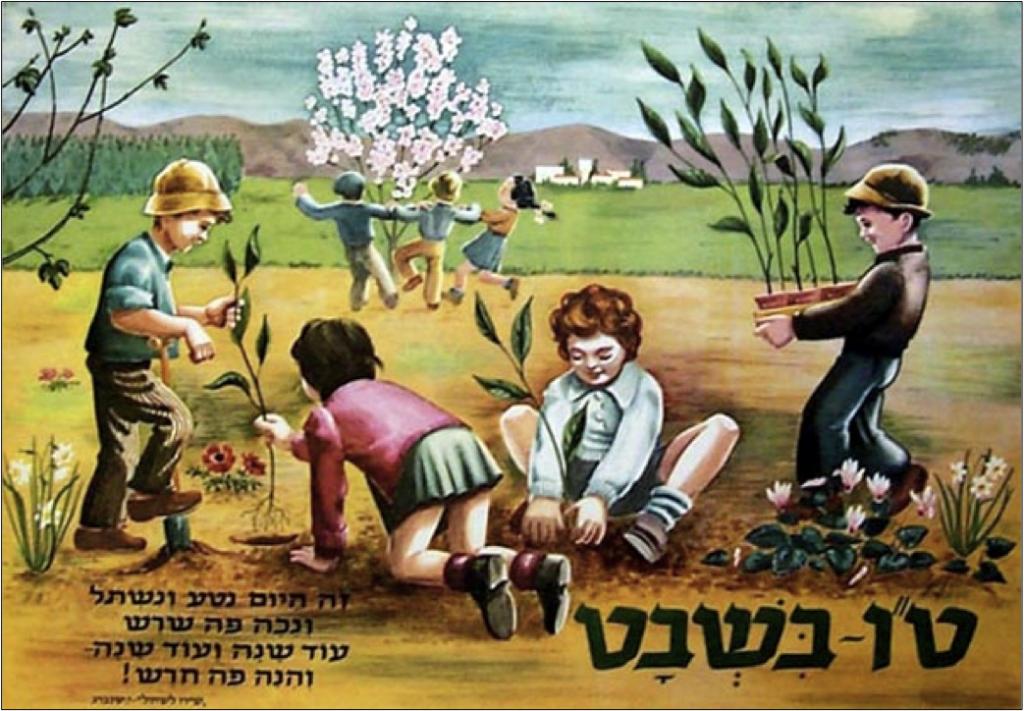In this poster, published circa 1950 by the Jewish National Fund (JNF), we see two groups of Jewish children celebrating the joys of nature while planting saplings in Israel. The children in the foreground are busy with the various tasks involved in transplantation and afforestation: the boy on the left uses a shovel to break soil as the girl on the left places a sapling in a freshly-dug hole. The seated girl tamps down the soil around a just-planted sapling while the boy on the right carries a potted sapling towards the area being worked. In this way, the major technical steps in afforestation are simplified and depicted both graphically and logically. The children in the background join hands and dance happily around a young tree in full bloom. Off in the distance are the low white buildings of the kibbutz (Hebrew: collective farm) where all these children live.
The kibbutz, although not a major visual element in the poster, is the central feature of the activities depicted. From it emanate all the restorative accomplishments of the kibbutz's residents: the barren mountains in the far distance show the signs of earlier reforestation efforts as patches of green forest; from the upper left hand corner a rich green line of pine trees extends out towards the middle of the poster; the grassy field is sharply delineated between two contrasting areas: the lush, verdant side closest to the kibbutz denoting the work of earlier generations of Zionist pioneers and the other an as-yet-untilled, hardscrabble soil which the children are working to revitalize. The subtext of this delineation is that the soil, which clearly has the potential to be rich and productive, was barren and neglected prior to the arrival of the Zionists.
This is a narrative poster and nothing in it is there by chance or as mere graphic embellishment; every visual element supports a narrative assertion. This poster reflects, in both visual and iconic forms, the two core activities of the Jewish National Fund; afforestation and reclamation. It also reinforces, in a creatively graphic way, the controversial Zionist recruitment slogan, promoted by author and playwright Israel Zangwill at the turn of the twentieth century that claimed Palestine was "a land without a people for a people without a land".
The choice of activities depicted reinforces a pivotal concept at the heart of the Zionist pioneer mentality: that of personal selflessness, group solidarity and working together "collectively" to accomplish stated goals. These children are not engaged in spontaneous or "parallel play": rather, they are united in a highly-structured activity, the object of which is to get the greenhouse-raised saplings into the ground to advance the process of rejuvenating the parched soil depicted in the poster. There is no direct mention or reference to the history of the land they are working and living on. But for the Hebrew text, this scene could be set in California, Spain or almost any western locale.
This poster was printed with the intent of strengthening one of Labor Zionism's central ideological claims: that the land belongs to those who work it. It is the saplings' potential to rejuvenate the soil thereby bringing it back to life that explains the tree's value as a symbol for Zionism. The subtext of this poster states that as these saplings grow into the soil so will the children who planted them grow into a new identity, one inseparable from the land. Moreover, just as the land is returning to its rightful state of fertility and productivity, so the Jewish people by the act of afforestation, will blossom into their authentic identities as workers of the land.
The goal of the poster and poem is to glorify the principles of Zionism, the land of Israel and those who nurture its productivity. By establishing a new national holiday dedicated to the tree, Tu Bishvat, Zionism asserts its ownership of the land and the symbol of the tree.
Translation of Hebrew text in lower left hand corner:
On this day we will plant and plant trees [two words basically meaning the same thing: to plant trees]
And we will set down roots here
Another year and another year—
And here is a grove!
Lyrics: Y. Shinberg (Israel)
Source: Text from Arab Studies athropology course (MAAS 554) Georgetown University, Fall 2008, written by Dan Walsh.
This poster is meant to be viewed in concert with another poster at this site: Fifty Years Under the Tent

